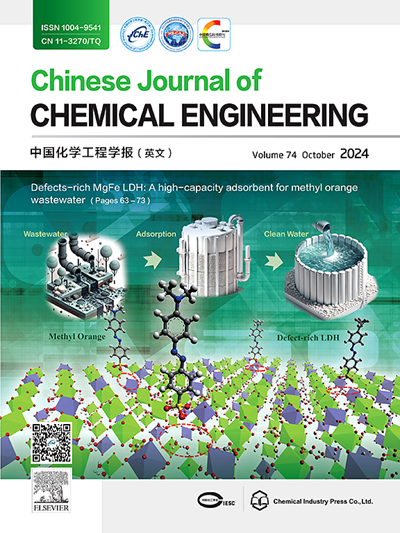煤与禽畜粪便加压流化床氧燃料共烧燃烧特性及污染物排放
IF 3.7
3区 工程技术
Q2 ENGINEERING, CHEMICAL
引用次数: 0
摘要
加压全氧燃烧是具有工业应用潜力的低成本新一代碳捕集技术。本文提出了一种创新性的研究探索——将煤加压流化床全氧燃烧技术与禽粪作为可再生碳中性燃料的能源利用相耦合,以捕获CO2并同时解决禽粪处理问题。本研究在典型的全氧燃料条件(30%O2/70%CO2,即Oxy-30)下,在实验室规模的加压流化床中实现了煤与鸡粪的稳定共燃烧。研究了燃烧压力(0.1 ~ 0.5 MPa)和鸡粪比例(0% ~ 100%)等关键参数对基本燃烧效率、碳转化率、氮硫污染物排放和残灰特性的影响。结果表明,加压有利于提高CO2富集浓度和流化床燃烧效率。在0.1和0.3 MPa下共燃时,当鸡粪掺混比(Mpm)为25%时,烟气中CO2浓度最高。尽管NO排放量随Mpm的增加而波动甚至增加,但煤与鸡粪共燃在降低NO转化率(XNO)方面表现出协同效应。加压对降低NO排放的作用显著,当压力(P)从0.1 MPa增加到0.5 MPa时,Mpm = 25%时的XNO排放量从15%下降到5%。当P从0.1 MPa增加到0.5 MPa, Mpm从0%增加到50%时,SO2的排放量和转化率降低。在加压氧燃料共燃烧过程中,自脱硫过程对降低SO2排放起着重要作用。本研究旨在推动加压流化床氧燃料共燃烧技术的发展和应用,促进畜禽粪便生物质的循环生物经济和无碳废物管理。本文章由计算机程序翻译,如有差异,请以英文原文为准。
Combustion behavior and pollutant emissions of the pressurized fluidized bed oxy-fuel co-firing of coal and poultry manure
Pressurized oxy-fuel combustion is a next-generation and low-cost carbon capture technology with industrial application potential. This work presents an innovative research exploration—coupling coal pressurized fluidized bed oxy-fuel combustion technology with energy utilization of poultry manure as a renewable and carbon-neutral fuel, in order to capture CO2 and solve the problem of poultry manure treatment simultaneously. In this study, a stable co-combustion of coal and chicken manure in a laboratory-scale pressurized fluidized bed under typical oxy-fuel condition (30%O2/70%CO2, i.e., Oxy-30) is achieved. The key parameters including the combustion pressure (0.1–0.5 MPa) and chicken-manure proportion (0% to 100%) and their impacts on fundamental combustion efficiency, carbon conversion, nitrogen and sulfur pollutant emissions, and residue ash characteristics have been investigated. The result show that pressurization favors an increase in the CO2 enrichment concentration and fluidized bed combustion efficiency. During co-combustion under 0.1 and 0.3 MPa, the CO2 concentration in the flue gas is the highest when the chicken manure blending ratio (Mpm) is 25%. Although the NO emissions fluctuate and even increase as Mpm increases, the co-combustion of coal and chicken manure exhibits a synergistic effect in reducing NO conversion rate (XNO). The effect of pressurization on reducing NO emission is significant, XNO at Mpm = 25% decreasing from 15% to 5% as the pressure (P) increases from 0.1 to 0.5 MPa. As P increases from 0.1 to 0.5 MPa and Mpm increases from 0% to 50%, the SO2 emissions and conversion rates decrease. The self-desulfurization process plays an important role in the reduction of SO2 emissions during pressurized oxy-fuel co-combustion. The aim of this work is to advance the development and application of pressurized fluidized bed oxy-fuel co-combustion technology and promote a circular bioeconomy and carbon-free waste management for biomass derived from livestock manure.
求助全文
通过发布文献求助,成功后即可免费获取论文全文。
去求助
来源期刊

Chinese Journal of Chemical Engineering
工程技术-工程:化工
CiteScore
6.60
自引率
5.30%
发文量
4309
审稿时长
31 days
期刊介绍:
The Chinese Journal of Chemical Engineering (Monthly, started in 1982) is the official journal of the Chemical Industry and Engineering Society of China and published by the Chemical Industry Press Co. Ltd. The aim of the journal is to develop the international exchange of scientific and technical information in the field of chemical engineering. It publishes original research papers that cover the major advancements and achievements in chemical engineering in China as well as some articles from overseas contributors.
The topics of journal include chemical engineering, chemical technology, biochemical engineering, energy and environmental engineering and other relevant fields. Papers are published on the basis of their relevance to theoretical research, practical application or potential uses in the industry as Research Papers, Communications, Reviews and Perspectives. Prominent domestic and overseas chemical experts and scholars have been invited to form an International Advisory Board and the Editorial Committee. It enjoys recognition among Chinese academia and industry as a reliable source of information of what is going on in chemical engineering research, both domestic and abroad.
 求助内容:
求助内容: 应助结果提醒方式:
应助结果提醒方式:


